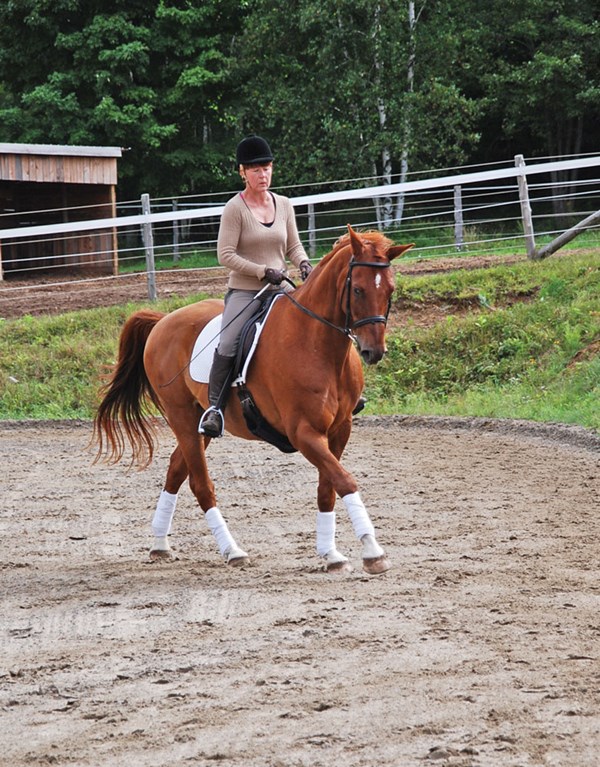
I had competed for many years at Fourth Level on my reliable Thoroughbred gelding, and when he retired at the age of 18, my competitive heart retired too. After 30 years in the ring, it was time to relax, seemed reasonable. Then one day three years ago, a friend called. She had a horse that needed a home.
Elke Mulholland, of Windswept Farms in Georgetown, Ontario, Canada, is not the usual person you might adopt a horse from. She heads a breeding operation that consistently produces some of the nicest horses in Canada’s competition rings. My curiosity was piqued. I made the trip to her farm and met Waltzking (Waltzy), an 11-year-old, 16.3-hand Hanoverian.
“The W line is a wonderful horse,” Elke said, “but sensitive, you know.” This would normally sound ominous but when you added in her German accent, it sounded quite forbidding. Waltzy went into the arena and floated. He had never been backed and looked like he had no intention of it. He performed tempi changes and passage seemingly just for fun in the paddock. He was up for adoption because he was blinded in both eyes in an accident as a 3-year-old. He was intended to become a foundation stallion for the farm, but once he became blind with only 30 percent vision in one eye, he had been turned out to look after the 2-year-olds.
I shipped him two hours north to a small country barn where we could get to know each other. He arrived in a blizzard, and we began to work together. We started with the usual training techniques for green horses—groundwork and longeing. All went well until the day a bear joined us. Our usual quiet longe session was going well, and then we both “saw” it. This was the first time it crossed my mind that Waltzy could see with more than his eyes. He smelled the bear, leapt in front of me and reared. This bravery was a harbinger of things to come.
With new faith in Waltzy, I took a deep breath one day and decided to swing into the saddle. I felt more pride as he stood there, trusting me, unable to see as I swung over his back, than I had at winning any competition. He understood all of my words—walk, trot, canter and halt on the longe line. But now what? Imagine my surprise when he worked happily with me as his rider. He flicked his ears at me as we rode around and I verbally told him his gaits, gradually introducing the leg and seat aids to go with them. Ears flicking constantly in my direction, Waltzy learned all three gaits in record time. I was a bit alarmed the day an old friend presented me with a picture of us proudly cantering around and Waltzy’s eyes were shut. Talk about realizing the importance of keeping your eyes up as a rider.
After year one, Waltzy began learning changes. I enlisted Grand Prix rider and trainer Lee Tubman to give a clinic at the farm. I sent Lee a photo and decided to keep the blind part to myself. It turns out, that was the right move, as Lee was determined to help us improve. “But he’s blind!” I finally wailed after one particularly insightful comment about our lack of straightness in the left change. Needless to say, this did not elicit the sympathy I had hoped for. “Don’t baby him. He can do it,” Lee said. And he was right. Waltzy learned his two tempis, clean and straight, and we began work on the passage. It would likely have gone more quickly if I could have parked a bear just outside the ring to help him lower his hocks.
Then one day the barn owner called me. Waltzy was colicking so badly that he couldn’t stand. His colic was the worst 12 hours of my life. Even thinking about it now still makes me cry. I held his head as the vet put him down. To the last moment he nuzzled me, which made it seem as though he was trying to make me feel better.
I missed him so much that I eventually had a mare bred to his full brother, another of Elke’s wonderful stallions. I am now the proud owner of his 3-year-old niece, Wavoom. Sometimes, when she looks at me out of the corner of her eye after a brave moment in her training, I see her uncle Waltzy looking back.












